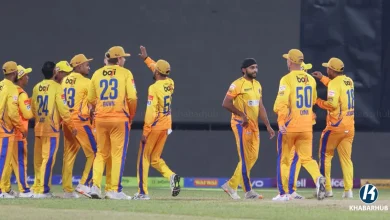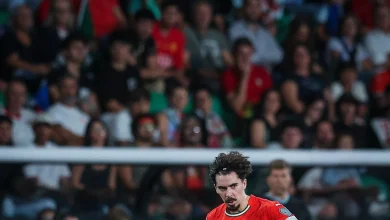‘Screaming’: Horror of deadly chopper crash

The Sea World Helicopter crash that claimed four lives left one survivor pinned under the wreckage, “screaming and screaming” for help, a court has been told.
The long-awaited public inquest into the deadly crash opened in Brisbane on Monday, drawing families, investigators and aviation experts into the courtroom nearly three years after the tragedy shocked the nation.
Harrowing footage of the mid-air collision was shown, giving a stark glimpse into the moments that claimed four lives and left three others critically injured.
The crash occurred on January 2, 2023, above the Gold Coast Broadwater when two Eurocopter EC130 helicopters, operated by Sea World Helicopters, collided just 130 feet (40m) above the water.
Chief pilot Ash Jenkinson, British tourists Ron and Diane Hughes, and Sydney mother Vanessa Tadros died instantly, while eight others, including three critically injured, were rushed to hospital.
One of the survivors of the downed helicopter, Winnie De Silva, told the inquest she had booked the scenic flight “as a spur of the moment” decision while inside the theme park with her son.
After watching a safety video, she said passengers were escorted to the gate and helped aboard, with staff checking their belts while the pilot entered the cabin only moments before departure.
“He only said one or two words,” she told the court, adding that he simply instructed passengers they could talk amongst themselves once their headsets were on.
“He was very straightforward.”
Ms De Silva said she had been looking out the window after take off when she sensed “something was happening outside.”
“I wasn’t very worried as I believed the pilot would take care of it,” she said.
That changed when “things started falling on our faces” and the cabin began violently shaking.
She recalled the pilot “pressing all the buttons … touching everywhere, all his fingers were moving” as the helicopter spun.
She remembered closing her eyes and telling her son to do the same before losing consciousness.
When she came to, she was trapped beneath the wreckage.
“I was just screaming and screaming for help,” she said.
She described feeling “hot things” on her body and aviation fuel pouring into her right ear as she lay pinned and helpless.
Bystanders reassured her that her son was safe, though she remained trapped until fire crews “cut the helicopter into small pieces”.
She remembered crying out, “my legs,” because she could not feel them.
Acting Senior Sergeant Justin Dunn from Gold Coast Water Police was among the first officers to reach the wreckage and told the inquest the scene was “absolute chaos”.
He said he arrived within minutes and immediately began searching for survivors.
Sergeant Dunn described walking around the “absolute wreck”, checking for signs of life as members of the public tried to resuscitate the injured.
He confirmed he found chief pilot Ash Jenkinson with “no signs of visible life” before continuing his sweep of the debris.
He described seeing “young Nicholas” (Tadros) being treated by members of the public and in a recovery position.
Sergeant Dunn then crawled beneath the shattered airframe where he found Ms De Silva trapped, as aviation fuel poured over both of them.
He said the heat radiating from the engines made the situation very dangerous.
A bystander stood above the wreck, repeatedly pouring water over the helicopter in an effort to cool the metal.
Sergeant Dunn told the court he stayed under the wreck for several minutes trying to support Ms De Silva, describing the conditions as “extremely hot”.
Council assisting Ian Harvey opened the inquest by reconstructing the sequence of events leading up to the collision.
Passengers’ phone footage, security cameras, and recordings from the Sea World helipad were shown in court, capturing the departing helicopter climbing south after takeoff while the returning helicopter approached from the southeast.
One passenger, Elmarie Steenberg, pointed frantically, tapping the pilot on the shoulder and gripping the seat rail in the seconds before impact.
The departing helicopter’s rotor mast and gearbox separated mid-air, sending it crashing uncontrollably onto a sandbar, flipping and collapsing the cabin.
The arriving helicopter, despite a shattered cockpit, managed to stabilise and land safely on the same sandbar, although several passengers sustained minor injuries from glass fragments.
Coroner Carol Lee emphasised at the start of the hearing that her role was not to determine criminal or civil liability but to establish exactly what happened and recommend measures to prevent a similar tragedy in the future.
Over the next two weeks, she will examine whether the pilots’ training, the operator’s safety systems, and the on-board equipment were adequate for safe operation.
Central to the inquest will be the findings of a damning 200-page report from the Australian Transport Safety Bureau, which identified a chain of compounding risk failures.
The report highlighted issues with aircraft design limiting pilot visibility, radio equipment that was faulty or degraded, missing or non-operational safety lighting, and a transponder on one helicopter that had been malfunctioning in the weeks leading up to the crash.
It also noted that the newer EC130 helicopters had been introduced into the fleet shortly before Christmas 2022, with pilots having limited “differences training” to operate the aircraft safely.
Mr Harvey revealed that the fatal collision was not entirely unprecedented.
Flight data analysed by Air Services Australia indicated that in the 90 days leading up to the crash, there had been at least five near-miss incidents between Sea World helicopters during takeoff and landing, with aircraft coming within about 200 feet (60m) of each other.
Most of these close calls occurred after the operator introduced new EC130 helicopters to its fleet in December 2022, highlighting concerns about pilot familiarity with the aircraft and whether safety procedures were sufficient to manage the increased operational risk.
The inquest is expected to examine whether these prior incidents were adequately reported and addressed and if lessons from them could have prevented the tragedy.
Mr Harvey said the line of sight between the two aircraft was partially blocked by a helicopter’s roof and structural pillars, and if Mr Jenkinson had been flying from the right-hand seat as he had in previous models, he may have been able to see the other helicopter and potentially avoid the collision.
He also told the court the footage and expert analysis would show the speed at which the distance between the helicopters closed, leaving almost no time for evasive action.
Mr Harvey highlighted the intense operational pressure facing Mr Jenkinson in the lead-up to the crash.
He said the rapid introduction of new EC130 helicopters into the fleet just weeks before the tragedy, combined with the company’s commercial push to meet holiday-season demand, created a high-pressure environment for pilots.
Mr Jenkinson was responsible not only for flying passengers but also for overseeing aspects of crew training and operational safety, navigating unfamiliar aircraft configurations with limited “differences training”.
At the close of his opening statement, Mr Harvey paused to acknowledge the victims’ families, his voice breaking as emotion overcame him and he struggled to continue.
More than 30 witnesses, including pilots, aviation safety specialists, engineers, first responders, and Sea World Helicopters management, are expected to give evidence.
They will provide insight into pilot experience, aircraft maintenance, company procedures, and safety oversight, as well as the circumstances surrounding the introduction of new aircraft into the fleet under tight time pressures.
The hearing is to run for more than two weeks.
More to come




